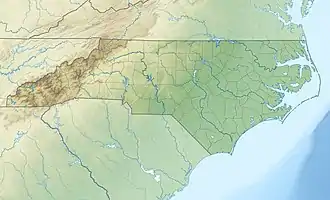Mud Lick Creek (Rocky River tributary)
Mud Lick Creek is a 5.57 mi (8.96 km) long 3rd order tributary to the Rocky River in Chatham County, North Carolina.
| Mud Lick Creek Tributary to Rocky River | |
|---|---|
 Location of Mud Lick Creek mouth  Mud Lick Creek (Rocky River tributary) (the United States) | |
| Location | |
| Country | United States |
| State | North Carolina |
| County | Chatham |
| Physical characteristics | |
| Source | Reedy Branch divide |
| • location | about 2 miles northeast of Crutchfield Crossroads, North Carolina |
| • coordinates | 35°50′13″N 079°24′49″W[1] |
| • elevation | 660 ft (200 m)[2] |
| Mouth | Rocky River |
• location | about 2 miles southwest of Crutchfield Crossroads, North Carolina |
• coordinates | 35°47′30″N 079°27′55″W[1] |
• elevation | 534 ft (163 m)[2] |
| Length | 5.57 mi (8.96 km)[3] |
| Basin size | 8.60 square miles (22.3 km2)[4] |
| Discharge | |
| • location | Rocky River |
| • average | 11.22 cu ft/s (0.318 m3/s) at mouth with Rocky River[4] |
| Basin features | |
| Progression | Rocky River → Deep River → Cape Fear River → Atlantic Ocean |
| River system | Deep River |
| Tributaries | |
| • left | unnamed tributaries |
| • right | unnamed tributaries |
| Bridges | Moon Lindley Road, Keith Nunn Drive, Siler City-Snow Camp Road, Silk Hope-Liberty Road, RC Overman Road |
Course
Mud Lick Creek rises about 2 miles northeast of Crutchfield Crossroads, North Carolina in Chatham County. Mud Lick Creek then flows southwest to join the Rocky River about 2 miles southwest of Crutchfield Crossroads.[2]
Watershed
Mud Lick Creek drains 8.60 square miles (22.3 km2) of area, receives about 47.7 in/year of precipitation, has a wetness index of 440.67 and is about 41% forested.[4]
References
- "GNIS Detail - Mud Lick Creek". geonames.usgs.gov. US Geological Survey. Retrieved 2 September 2020.
- "Mud Lick Creek Topo Map in Chatham". TopoZone. Locality, LLC. Retrieved 2 September 2020.
- "ArcGIS Web Application". epa.maps.arcgis.com. US EPA. Retrieved 2 September 2020.
- "Mud Lick Creek Watershed Report". US EPA Geoviewer. US EPA. Retrieved 2 September 2020.
This article is issued from Wikipedia. The text is licensed under Creative Commons - Attribution - Sharealike. Additional terms may apply for the media files.